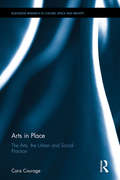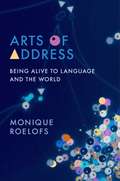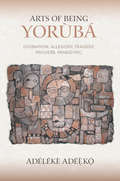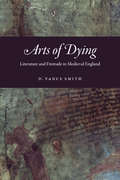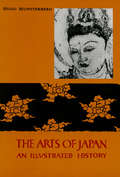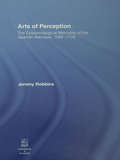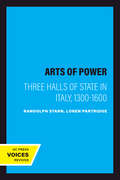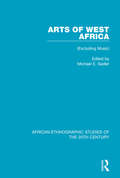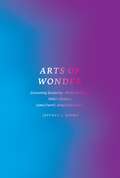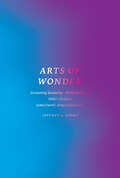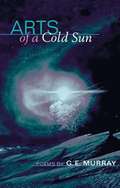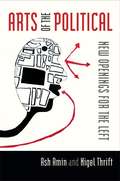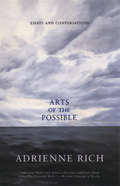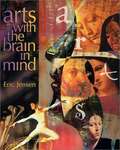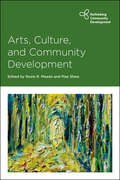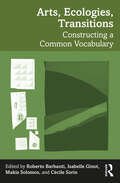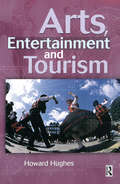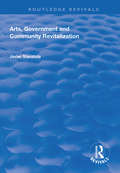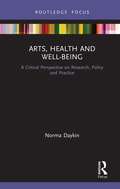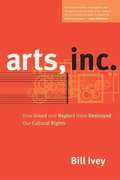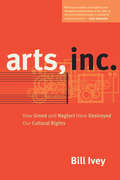- Table View
- List View
Arts in Place: The Arts, the Urban and Social Practice (Routledge Research in Culture, Space and Identity)
by Cara CourageThis interdisciplinary book explores the role of art in placemaking in urban environments, analysing how artists and communities use arts to improve their quality of life. It explores the concept of social practice placemaking, where artists and community members are seen as equal experts in the process. Drawing on examples of local level projects from the USA and Europe, the book explores the impact of these projects on the people involved, on their relationship to the place around them, and on city policy and planning practice. Case studies include Art Tunnel Smithfield, Dublin, an outdoor art gallery and community space in an impoverished area of the city; The Drawing Shed, London, a contemporary arts practice operating in housing estates and parks in Walthamstow; and Big Car, Indianapolis, an arts organisation operating across the whole of this Midwest city. This book offers a timely contribution, bridging the gap between cultural studies and placemaking. It will be of interest to scholars, students and practitioners working in geography, urban studies, architecture, planning, sociology, cultural studies and the arts.
Arts of Address: Being Alive to Language and the World (Columbia Themes in Philosophy, Social Criticism, and the Arts)
by Monique RoelofsModes of address are forms of signification that we direct at living beings, things, and places, and they at us and at each other. Seeing is a form of address. So are speaking, singing, and painting. Initiating or responding to such calls, we participate in encounters with the world. Widely used yet less often examined in its own right, the notion of address cries out for analysis.Monique Roelofs offers a pathbreaking systematic model of the field of address and puts it to work in the arts, critical theory, and social life. She shows how address props up finely hewn modalities of relationality, agency, and normativity. Address exceeds a one-on-one pairing of cultural productions with their audiences. As ardently energizing tiny slippages and snippets as fueling larger impulses in the society, it activates and reaestheticizes registers of race, gender, class, coloniality, and cosmopolitanism. In readings of writers and artists ranging from Julio Cortázar to Jamaica Kincaid and from Martha Rosler to Pope.L, Roelofs demonstrates the centrality of address to freedom and a critical political aesthetics. Under the banner of a unified concept of address, Hume, Kant, and Foucault strike up conversations with Benjamin, Barthes, Althusser, Fanon, Anzaldúa, and Butler. Drawing on a wide array of artistic and theoretical sources and challenging disciplinary boundaries, the book illuminates address’s significance to cultural existence and to our reflexive aesthetic engagement in it. Keeping the reader on the lookout for flash fiction that pops up out of nowhere and for insurgent whisperings that take to the air, Arts of Address explores the aliveness of being alive.
Arts of Being Yoruba: Divination, Allegory, Tragedy, Proverb, Panegyric
by Adélékè AdéèkóThere is a culturally significant way of being Yorùbá that is expressed through dress, greetings, and celebrations—no matter where in the world they take place. Adélékè Adék documents Yorùbá patterns of behavior and articulates a philosophy of how to be Yorùbá in this innovative study. As he focuses on historical writings, Ifá divination practices, the use of proverbs in contemporary speech, photography, gendered ideas of dressing well, and the formalities of ceremony and speech at celebratory occasions, Adéékó contends that being Yorùbá is indeed an art and Yorùbá-ness is a dynamic phenomenon that responds to cultural shifts as Yorùbá people inhabit an increasingly globalized world.
Arts of Dying: Literature and Finitude in Medieval England
by D. Vance SmithPeople in the Middle Ages had chantry chapels, mortuary rolls, the daily observance of the Office of the Dead, and even purgatory—but they were still unable to talk about death. Their inability wasn’t due to religion, but philosophy: saying someone is dead is nonsense, as the person no longer is. The one thing that can talk about something that is not, as D. Vance Smith shows in this innovative, provocative book, is literature. Covering the emergence of English literature from the Old English to the late medieval periods, Arts of Dying argues that the problem of how to designate death produced a long tradition of literature about dying, which continues in the work of Heidegger, Blanchot, and Gillian Rose. Philosophy’s attempt to designate death’s impossibility is part of a literature that imagines a relationship with death, a literature that intensively and self-reflexively supposes that its very terms might solve the problem of the termination of life. A lyrical and elegiac exploration that combines medieval work on the philosophy of language with contemporary theorizing on death and dying, Arts of Dying is an important contribution to medieval studies, literary criticism, phenomenology, and continental philosophy.
Arts of Impoverishment: Beckett, Rothko, Resnais
by Leo Bersani Ulysse DutoitWhy taunt and flout us, as Beckett's writing does? Why discourage us from seeing, as Mark Rothko's paintings often can? Why immobilize and daze us, as Alain Resnais' films sometimes will? Why, Leo Bersnai and Ulysse Dutoit ask, would three acknowledged masters of their media make work deliberately opaque and inhospitable to an audience? This book shows how such crippling moves may signal a profoundly original - and profoundly anti-modernist - renunciation of art's authority.
Arts of Japan
by Hugo MunsterbergArts of Japan was originally published by Tuttle Publishing in print form in 1957.<P><P> This book," in the words of the author, "represents an attempt to fill a long-felt need for an account of the history of Japanese art which would deal with the crafts as well as with the so-called fine arts and carry the story of Japanese art up to the present day instead of ending with the death of Hiroshige." The reader will quickly perceive how well this aim has been achieved. Here, in a stimulating and informative text and 121 well-selected plates -12 in full colour-is a dynamic treatment of the various influences that have shaped the course of Japanese art history in the fields of painting, sculpture, architecture, and handicrafts. Discussed with challenging insight are the impact of the various Indian and Chinese schools, the pervasive influenceof Zen philosophy, and the many other artistic developments, giving the reader awell-rounded picture of the great significance and contribution of Japanese art. Special features of the book are sections on handicrafts and a chapter on prehistoric art. The book comes at a time when there is an awakened interest in Oriental art throughout the world. At the same time new methods of art research have been so expanded and refined that many interpretations of earlier writers have been made obsolete. Because of linguistic barriers, political upheavals, and the limited number of specialists, misconceptions have been especially numerous in the field of Oriental art. THE ARTS OF JAPAN admirably corrects these misinterpretations, consolidates the results of the most recent scholarship, and in one compact volume presents an up-to-date, authoritative survey of Japanese an throughout its long history and in all its colorful diversity.
Arts of Living on a Damaged Planet: Ghosts and Monsters of the Anthropocene
by Anna Lowenhaupt Tsing Nils Bubandt Elaine Gan Heather Anne SwansonLiving on a damaged planet challenges who we are and where we live. This timely anthology calls on twenty eminent humanists and scientists to revitalize curiosity, observation, and transdisciplinary conversation about life on earth.As human-induced environmental change threatens multispecies livability, Arts of Living on a Damaged Planet puts forward a bold proposal: entangled histories, situated narratives, and thick descriptions offer urgent &“arts of living.&” Included are essays by scholars in anthropology, ecology, science studies, art, literature, and bioinformatics who posit critical and creative tools for collaborative survival in a more-than-human Anthropocene. The essays are organized around two key figures that also serve as the publication&’s two openings: Ghosts, or landscapes haunted by the violences of modernity; and Monsters, or interspecies and intraspecies sociality. Ghosts and Monsters are tentacular, windy, and arboreal arts that invite readers to encounter ants, lichen, rocks, electrons, flying foxes, salmon, chestnut trees, mud volcanoes, border zones, graves, radioactive waste—in short, the wonders and terrors of an unintended epoch.Contributors: Karen Barad, U of California, Santa Cruz; Kate Brown, U of Maryland, Baltimore; Carla Freccero, U of California, Santa Cruz; Peter Funch, Aarhus U; Scott F. Gilbert, Swarthmore College; Deborah M. Gordon, Stanford U; Donna J. Haraway, U of California, Santa Cruz; Andreas Hejnol, U of Bergen, Norway; Ursula K. Le Guin; Marianne Elisabeth Lien, U of Oslo; Andrew Mathews, U of California, Santa Cruz; Margaret McFall-Ngai, U of Hawaii, Manoa; Ingrid M. Parker, U of California, Santa Cruz; Mary Louise Pratt, NYU; Anne Pringle, U of Wisconsin, Madison; Deborah Bird Rose, U of New South Wales, Sydney; Dorion Sagan; Lesley Stern, U of California, San Diego; Jens-Christian Svenning, Aarhus U.
Arts of Perception: The Epistemological Mentality of the Spanish Baroque, 1580-1720
by Jeremy RobbinsArts of Perception offers a new account of a key period in Spanish history and culture and a fundamental reassessment of its major writers and intellectuals, including Gracián, Quevedo, Calderón, Saavedra Fajardo, López de Vega, and Sor Juana. Reading these figures in the context of European thought and the new science, and philosophy, the study considers how they developed various ‘arts of perception’ - complex perceptual strategies designed to overcome and exploit epistemic problems to enable an individual to act effectively in the moral, political, social or religious sphere. The study takes as its subject the distinctive epistemological mentality behind such ‘arts of perception’. This mentality was fostered by the creative interaction of scepticism and Stoicism, and found expression in the key concepts ser/parecer and engaño/desengaño. The work traces the emergence, development, and impact of these concepts on Spanish thought and culture. As well as offering new interpretations of specific major figures, Arts of Perception offers an interpretation of the mentality of an entire culture as it made the fraught transition to intellectual modernity. As such it ranges over numerous discourses and formative contexts and provides a wealth of new material which will be of use to all those seeking to understand and interpret the literature, culture and thought of Golden Age Spain. This book was previously published as a special issue of The Bulletin of Spanish Studies.
Arts of Power: Three Halls of State in Italy, 1300-1600 (The New Historicism: Studies in Cultural Poetics #19)
by Randolph Starn Loren PartridgeThis title is part of UC Press's Voices Revived program, which commemorates University of California Press’s mission to seek out and cultivate the brightest minds and give them voice, reach, and impact. Drawing on a backlist dating to 1893, Voices Revived makes high-quality, peer-reviewed scholarship accessible once again using print-on-demand technology. This title was originally published in 1992.This title is part of UC Press's Voices Revived program, which commemorates University of California Press’s mission to seek out and cultivate the brightest minds and give them voice, reach, and impact. Drawing on a backlist dating to 1893, Voices Revived</DIV
Arts of West Africa: (Excluding Music) (Black Heritage Library Collection)
by Michael E. SadlerOriginally published in 1935, the aim of this book was to introduce the European to the art of West Africa. Many of the examples (extensively illustrated with black and white photos are from the regions between Senegal and Angola, primarily from Gambia, Sierra Leone, the Gold Coast, Nigeria and the Cameroons. Although the art and sculpture of West Africa is coherent, there are tribal and territorial characteristics which are discussed as is the significance of masks in ritual ceremony.
Arts of Wonder: Enchanting Secularity--Walter De Maria, Diller + Scofidio, James Turrell, Andy Goldsworthy
by Jeffrey L. Kosky"The fate of our times is characterized by rationalization and intellectualization and, above all, by 'the disenchantment of the world. '" Max Weber's statement remains a dominant interpretation of the modern condition: the increasing capabilities of knowledge and science have banished mysteries, leaving a world that can be mastered technically and intellectually. And though this idea seems empowering, many people have become disenchanted with modern disenchantment. Using intimate encounters with works of art to explore disenchantment and the possibilities of re-enchantment, Arts of Wonder addresses questions about the nature of humanity, the world, and God in the wake of Weber's diagnosis of modernity. Jeffrey L. Kosky focuses on a handful of artists--Walter De Maria, Diller + Scofidio, James Turrell, and Andy Goldworthy--to show how they introduce spaces hospitable to mystery and wonder, redemption and revelation, and transcendence and creation. What might be thought of as religious longings, he argues, are crucial aspects of enchanting secularity when developed through encounters with these works of art. Developing a model of religion that might be significant to secular culture, Kosky shows how this model can be employed to deepen interpretation of the art we usually view as representing secular modernity. A thoughtful dialogue between philosophy and art, Arts of Wonder will catch the eye of readers of art and religion, philosophy of religion, and art criticism.
Arts of Wonder: Enchanting Secularity—Walter De Maria, Diller + Scofidio, James Turrell, Andy Goldsworthy (Religion And Postmodernism Ser.)
by Jeffrey L. Kosky“The fate of our times is characterized by rationalization and intellectualization and, above all, by ‘the disenchantment of the world.’” Max Weber’s statement remains a dominant interpretation of the modern condition: the increasing capabilities of knowledge and science have banished mysteries, leaving a world that can be mastered technically and intellectually. And though this idea seems empowering, many people have become disenchanted with modern disenchantment. Using intimate encounters with works of art to explore disenchantment and the possibilities of re-enchantment, Arts of Wonder addresses questions about the nature of humanity, the world, and God in the wake of Weber’s diagnosis of modernity. Jeffrey L. Kosky focuses on a handful of artists—Walter De Maria, Diller + Scofidio, James Turrell, and Andy Goldsworthy—to show how they introduce spaces hospitable to mystery and wonder, redemption and revelation, and transcendence and creation. What might be thought of as religious longings, he argues, are crucial aspects of enchanting secularity when developed through encounters with these works of art. Developing a model of religion that might be significant to secular culture, Kosky shows how this model can be employed to deepen interpretation of the art we usually view as representing secular modernity. A thoughtful dialogue between philosophy and art, Arts of Wonder will catch the eye of readers of art and religion, philosophy of religion, and art criticism.
Arts of a Cold Sun: POEMS
by G. E. MurrayIn these poems, G. E. Murray blends the colors of the soul with those of the world it brushes up against, exploring the ways in which art, both as possession and possessor, informs perception. Viewing his subjects sometimes from airplane altitude, sometimes from the intimacy of a shared restaurant table, Murray crafts "true stories about color," narratives of dislocation and belonging that invite readers to question their own relationship to art. Included in this volume is a long sequential poem titled "The Seconds," which Murray composed across the second days of thirteen months. The rhythms of this diary-as-poem seize the tensions of shifting times and locales, capturing the essences of moments that are at once chosen and arbitrary. "Codes toward an Incidental City," the sequence that closes the book, is a confederacy of forty poems that delve into the concrete familiarities and mythologies of urban landscapes, illuminating the ecstasies of city life.
Arts of the Political: New Openings for the Left
by Ash Amin Thrift NigelIn the West, "the Left," understood as a loose conglomeration of interests centered around the goal of a fairer and more equal society, still struggles to make its voice heard and its influence felt, even amid an overwhelming global recession. In Arts of the Political: New Openings for the Left, Ash Amin and Nigel Thrift argue that only by broadening the domain of what is considered political and what can be made into politics will the Left be able to respond forcefully to injustice and inequality. In particular, the Left requires a more imaginative and experimental approach to the politics of creating a better society. The authors propose three political arts that they consider crucial to transforming the Left: boosting invention, leveraging organization, and mobilizing affect. They maintain that successful Left political movements tend to surpass traditional notions of politics and open up political agency to these kinds of considerations. In other words, rather than providing another blueprint for the future, Amin and Thrift concentrate their attention on a more modest examination of the conduct of politics itself and the ways that it can be made more effective.
Arts of the Possible: Essays and Conversations
by Adrienne Rich"Adrienne Rich's new prose collection could have been titled The Essential Rich."--Women's Review of Books These essays trace a distinguished writer's engagement with her time, her arguments with herself and others. "I am a poet who knows the social power of poetry, a United States citizen who knows herself irrevocably tangled in her society's hopes, arrogance, and despair," Adrienne Rich writes. The essays in Arts of the Possible search for possibilities beyond a compromised, degraded system, seeking to imagine something else. They call on the fluidity of the imagination, from poetic vision to social justice, from the badlands of political demoralization to an art that might wound, that may open scars when engaged in its work, but will finally suture and not tear apart. This volume collects Rich's essays from the last decade of the twentieth century, including four earlier essays, as well as several conversations that go further than the usual interview. Also included is her essay explaining her reasons for declining the National Medal for the Arts. "The work is inspired and inspiring."--Alicia Ostriker "[S]o clear and clean and thorough. I learn from her again and again."--Grace Paley
Arts with the Brain in Mind
by Eric JensenHow do the arts stack up as a major discipline? What is their effect on the brain, learning, and human development? How might schools best implement and assess an arts program? Eric Jensen answers these questions--and more--in this book. To push for higher standards of learning, many policymakers are eliminating arts programs. To Jensen, that's a mistake. This book presents the definitive case, based on what we know about the brain and learning, for making arts a core part of the basic curriculum and thoughtfully integrating them into every subject. Separate chapters address musical, visual, and kinesthetic arts in ways that reveal their influence on learning. What are the effects of a fully implemented arts program? The evidence points to the following: * Fewer dropouts* Higher attendance* Better team players * An increased love of learning* Greater student dignity* Enhanced creativity* A more prepared citizen for the workplace of tomorrow* Greater cultural awareness as a bonus To Jensen, it's not a matter of choosing, say, the musical arts over the kinesthetic. Rather, ask what kind of art makes sense for what purposes. How much time per day? At what ages? What kind of music? What kind of movement? Should the arts be required? How do we assess arts programs? In answering these real-world questions, Jensen provides dozens of practical, detailed suggestions for incorporating the arts into every classroom.
Arts, Culture and Community Development (Rethinking Community Development)
by Rosie R. Meade and Mae ShawHow and why are arts and cultural practices meaningful to communities? Highlighting examples from Lebanon, Latin America, China, Ireland, India, Sri Lanka and beyond, this exciting book explores the relationship between the arts, culture and community development. Academics and practitioners from six continents discuss how diverse communities understand, re-imagine or seek to change personal, cultural, social, economic or political conditions while using the arts as their means and spaces of engagement. Investigating the theory and practice of ‘cultural democracy’, this book explores a range of aesthetic forms including song, music, muralism, theatre, dance, and circus arts.
Arts, Culture, and Blindness: A Study of Blind Students in the Visual Arts
by Simon HayhoeThis book explores one of the most powerful myths in modern society: the myth that blind people are incapable of understanding and creating visual arts.
Arts, Ecologies, Transitions: Constructing a Common Vocabulary
by Makis Solomos Roberto Barbanti Isabelle Ginot Cécile SorinArts, Ecologies, Transitions provides in-depth insights into how aesthetic relations and current artistic practices are fundamentally ecological and intrinsically connected to the world. As art is created in a given historic temporality, it presents specific modalities of productive and sensory relations to the world. With contributions from 49 researchers, this book tracks evolutions in the arts that demonstrate an awareness of the environmental, economic, social, and political crises. It proposes interdisciplinary approaches to art that clarify the multiple relationships between art and ecology through an exploration of key concepts such as collapsonauts, degrowth, place, recycling, and walking art. All the artistic fields are addressed from the visual arts, theatre, dance, music and sound art, cinema, and photography – including those that are rarely represented in research such as digital creation or graphic design – to showcase the diversity of artistic practices in transition.Through original research this book presents ideas in an accessible format and will be of interest to students and researchers in the fields of environmental studies, ecology, geography, cultural studies, architecture, performance studies, visual arts, cinema, music, and literature studies.
Arts, Entertainment and Tourism
by Howard Hughes'Arts, Entertainment and Tourism' is a pioneering text that, by focusing on the consumer, investigates the relationship between these 3 industries and how this relationship can be developed to its best competitive advantage. Issue-led, this text draws on appropriate disciplines rather than using one single approach, to examine issues in arts and entertainment within the framework of cultural tourism.Written to meet the needs of students studying on management courses in the arts, tourism and leisure, 'Arts, Entertainment and Tourism':* Describes the general arts and tourism background* Identifies a framework for analysis that acknowledges differing levels of interest in the arts and entertainment* Discusses the arts and entertainment that feature (past and present) in tourism * Examines the reasons why the arts, entertainment and tourism have an interest in each other and how they go about developing the relationship* Examines the relationship: are there tourists in audiences and do the arts and entertainment attract tourists to a destination?* Evaluates the wider effects (good and bad) on both the arts and tourism* Discusses the direction of future developments by arts and tourism organizations and for future research
Arts, Government and Community Revitalization (Routledge Revivals)
by Javier StanziolaFirst published in 1999, this book goes beyond the standard economic tools used to evaluate the effectiveness of arts in redevelopment processes. It assumes that the sectors involved in the process of arts-led community revitalization (artists, non-profit organizations, government and for-profit firms) act upon the economic structure and initiate a resurgence path. This assumption allows us to study the political and economic interaction among these sectors, understand their incentives and define and explore their boundaries. This book explores the 1) cultural and regeneration reasons for revitalization; 2) sources of funds; 3) political interaction; 4) definition and estimation of output; 5) evaluation of output; 6) estimation of coefficients and multipliers effects obtained from input-output tables.
Arts, Health and Well-Being: A Critical Perspective on Research, Policy and Practice
by Norma DaykinThis important book develops a critical understanding of the bridging of arts and health domains, drawing on models and perspectives from social sciences to develop the case for arts and health as a social movement. This interdisciplinary perspective offers a new research agenda that can help to inform future developments and sustainability in arts, health and well-being. Daykin begins with an overview of the current evidence base and a review of current challenges for research, policy and practice. Later chapters explore the international field of health and the arts; arts, with well-being as a social movement; and boundary work and the role of boundary objects in the field. The book also includes sections summarising research findings and evidence in arts and health research and examples from specific research projects conducted by the author, chosen to highlight particularly widespread challenges across many arts, health and well-being contexts. Arts, Health and Well-Being: A Critical Perspective on Research, Policy and Practice is valuable reading for students in sociology, psychology, social work, nursing, psychiatry, creative and performing arts, public health and policymakers and practitioners in these fields.
Arts, Inc.: How Greed and Neglect Have Destroyed Our Cultural Rights
by Bill IveyIn this impassioned and persuasive book, Bill Ivey assesses the current state of the arts in America and finds cause for alarm. Even as he celebrates our ever-emerging culture and the way it enriches our lives here at home while spreading the dream of democracy around the world, he points to a looming crisis.
Arts, Inc.: How Greed and Neglect Have Destroyed Our Cultural Rights
by Bill IveyIn this impassioned and persuasive book, Bill Ivey, the former chairman of the National Endowment for the Arts, assesses the current state of the arts in America and finds cause for alarm. Even as he celebrates our ever-emerging culture and the way it enriches our lives here at home while spreading the dream of democracy around the world, he points to a looming crisis. The expanding footprint of copyright, an unconstrained arts industry marketplace, and a government unwilling to engage culture as a serious arena for public policy have come together to undermine art, artistry, and cultural heritage--the expressive life of America. In eight succinct chapters, Ivey blends personal and professional memoir, policy analysis, and deeply held convictions to explore and define a coordinated vision for art, culture, and expression in American life.
